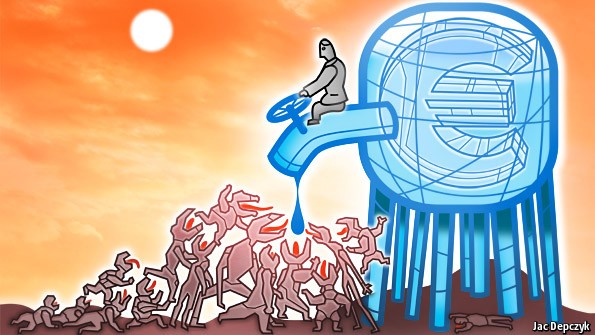Quantitative Easing Economics Guide
Post on: 4 Май, 2015 No Comment

When we hear monetary policy news, it’s usually of the form today the Fed decided to raise/lower interest rates by X%. We live in a capitalistic enough society that interest rates are determined by the forces of supply and demand, so it’s not like the Fed can just directly dictate what they are. Instead, the Fed has a number of indirect tools at its disposal. The most commonly used tool is open market operations, which is just a fancy term for buying and selling government bonds. When the Fed buys bonds, it takes in a bond and puts money out into the system. When it sells bonds, it gives out a bond and takes money out of the system. Therefore,
buying bonds increases the money supply and selling bonds reduces it.
As it turns out, an increase in the money supply lowers interest rates, and a reduction in the money supply raises them. Why is this? As a consumer, you probably don’t keep all of your wealth in cash stuffed under your mattress, and the reason that you don’t do this (other than bedtime discomfort) is that cash under the mattress doesn’t earn interest. There is an opportunity cost of holding money, and this cost gets bigger as interest rates go up. It’s not surprising, then, that interest rates go lower when the money supply increases. since the lower interest rates make people more willing to hold the extra cash.
Why would the Fed want to lower interest rates? Lower interest rates (at least theoretically) have a stimulating effect on the economy because they make it more attractive to borrow and invest and more attractive to spend rather than save. The downside of increasing the money supply as a means of stimulating the economy is that it, if left unchecked, will eventually lead to increased inflation as people acclimate to the increased amount of money in the system. (In other words, we’ll eventually have more money chasing the same number of goods and services, so things will become more expensive.)

The above discussion shows how open market operations work in the normal course of the economy. It’s relevant to mention, however, that this process has a somewhat severe limitation in that (nominal) interest rates can’t go below zero percent — i.e. policy makers haven’t figured out a good way to induce buyers to invest in assets that will give a negative return. When the economy bumps up against that zero percent threshold but still need to jump start the economy, the Fed has to come up with a new plan of action. This is where quantitative easing comes in.
Quantitative easing is defined as buying financial assets (eg. bonds) from banks via open market operations in order to flood them with reserves (read, cash in the vault) in hopes that they will lend it out and start a virtuous cycle of investment and consumption. This is a bit confusing, since it’s unclear how quantitative easing is any different from what the Fed does in the normal course of its business. The main differences are that, with quantitative easing. the Fed is buying long-term rather than short-term bonds (as is done with typical open market operations ) and that it has a money supply target rather than an interest rate target. In this way, quantitative easing is an attempt to lower longer term interest rates than those targeted in typical monetary policy. Quantitative easing comes with the same inflationary concerns as all expansionary monetary policy. and is in fact sometimes used as an attempt to combat deflation, which can have negative effects on an economy.
Some economists believe that monetary policy can increase output and employment in the short run. but even they acknowledge that in the long run the economy will revert back to its original level and will have experienced increased inflation in the process. Other economists think that monetary policy can only trick people into producing and spending more if it comes as a surprise. Still others believe that monetary policy only results in increased inflation and has a negligible impact on real output, even in the short run.














